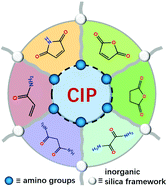Cluster-luminescent polysiloxane nanomaterials: adjustable full-color ultralong room temperature phosphorescence and a highly sensitive response to silver ions†
Abstract
Non-conjugated cluster luminescent materials have attracted much attention because of their good biocompatibility and low environmental toxicity. However, it has been difficult to achieve tunable cluster luminescent nanomaterials. Herein, a series of non-conjugated polysiloxane nanomaterials are synthesized from organosiloxane by a low temperature solution method. Polysiloxanes with terminal groups of amino (PAS) and urea (PUS) exhibit high luminescence quantum yield and long-lived room temperature phosphorescence (RTP) due to the formation of suitable spatial clusters. Interestingly, doping different types and contents of nonaromatic guest small molecules can effectively regulate the structure and composition of the clusters in polysiloxanes, thus resulting in full-color unconventional cluster luminescence with high quantum yield (up to 44%), long lifetime (up to 560 ms), and emission wavelengths from 380 nm to 753 nm. Additionally, the fluorescence and RTP of PAS are very sensitive to silver ions, which can be used to probe Ag+ in aqueous solutions with a detection limit as low as 0.027 nM. This double response detection can not only avoid the interference of background fluorescence, but also verify the accuracy of experimental results.

- This article is part of the themed collection: FOCUS: Metal and Metal-Containing Clusters


 Please wait while we load your content...
Please wait while we load your content...